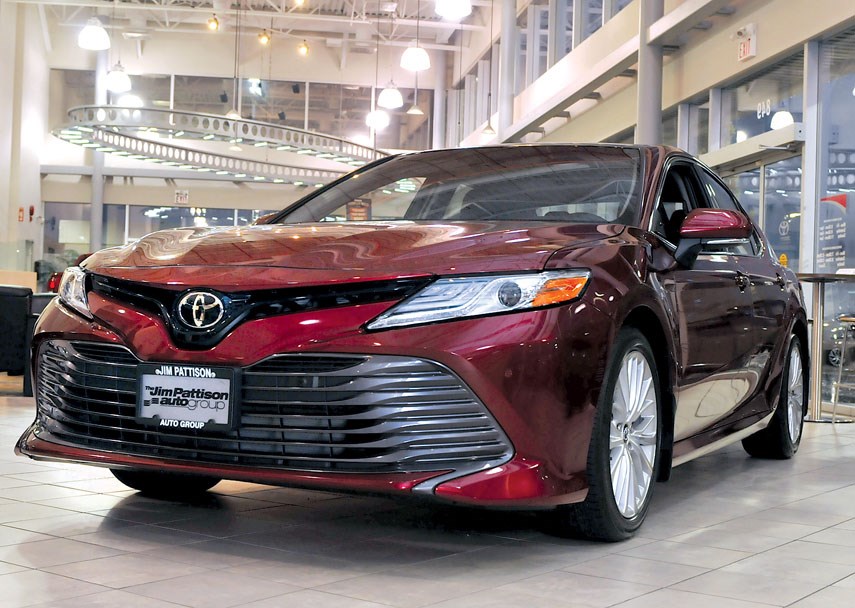The Camry has been the bestselling car in North America for 15 consecutive years.
Even with such an impressive track record, Toyota isn’t resting on its laurels and has decided to overhaul the Camry lineup inside and out for 2018. The impressive result is a gamble that will surely pay off for Toyota and its new owners.
The new Camry signals an important change for Toyota, which is strategizing to create a different brand for the future – one that excites the buyers through agile handling and sporty design. It’s something that’s hard to believe could happen with this “safe and reliable” brand, but the new Camry is an indication that the wind is indeed shifting at this global auto maker.
Design
The framework for this new and improved Camry comes from the Toyota New Global Architecture, which debuted on the new Prius. With TNGA, Torsional rigidity is increased by a whopping 30 per cent and, as a result, handling, steering feel, and ride are all improved. The 2018 Camry comes in four trim levels on top of the base (L) level: LE, XLE, SE, XSE.
The styling differs slightly depending on the model you get, but in all cases the new Camry wows the audience with a dynamic and intense-looking design that’s rare in a family mid-size car segment. “Is this really a Camry?” is the question that keeps coming up in my head as I glance at it from different angles. Honestly – at least from a distance – you can easily mistake the humble-priced Camry for a BMW or an Audi.
The combination of all these design features plus even sportier styling on the XSE makes the vehicle look like it should be in a whole different class. There are 10 models available, ranging from four-cylinder models all the way to hybrids and V-6 models.
The vehicle feels roomy inside, especially for the passengers in the backseat. Toyota has used many soft-touch materials, making the vehicle an inviting place. The trunk is also exceptionally roomy with 15.1 cubic feet available for storage. The redesigned hinges in the trunk hatch make injuries less likely as well.
The interior design is futuristic and once again a departure from the look and feel of an average family car. Toyota has its own infotainment system, and therefore still does not offer Apple Play or Android Auto, which is unfortunate. It does have connectivity options, but they are not as convenient or smooth-running as some of the other systems on the market. The dashboard and console look sleeker and less drab than previous years without sacrificing any of Camry’s legendary ergonomics and ease-of-use buttons.
Performance
Three powertrains are offered for the 2018, coupled with a brand new eight-speed automatic transmission: a 203 horsepower, 2.5-litre, four-cylinder engine; a 3.5-litre V-6 engine that delivers 301 h.p.; and the 208 net h.p. Hybrid Synergy Drive System which utilizes a continuously variable transmission.
The hybrid is a great option if you are looking to invest into the future and support the movement towards eco cars – it is actually faster than the base car and almost as fast as the V-6, while offering much better fuel economy than both. It has a lower centre of gravity than previous models (by one inch), which provides the driver with better handling. The Camry also features a new double-wishbone rear suspension which contributes to the improved handling over previous models. Three driving modes are available: Eco, Normal, and Sport.
What is most surprising is the overall handling and the feel of the new Camry. The 2017 models were soft and mushy. In comparison, the 2018s are European-like and vastly better in feel. The steering has a nice tactile feel with just the enough “weight” to make it competitive with most top European sedans while clearly outperforming the standard sedans from other Japanese brands.
Given the impressive drivability of this vehicle, the base engine is a tad “normal” in that it provides sufficient power but the engine noise can be intrusive during hard acceleration for the four-cylinder model.
Another new standard feature for 2018 is the collision avoidance and mitigation system; radar and camera are used in conjunction in the Toyota Safety Sense feature for pedestrian detection and collision avoidance. This feature is now standard in this vehicle and includes automatic high beams, adaptive cruise control, lane departure warning and steering assist.
Summary
Starting from $26,390 and moving up to a top price of $40,990, the redesigned Toyota Camry raises the bar for family sedans. The real question is: Could the 2018 Toyota Camry stand up against its competitors such as the Honda Accord, Mazda 6, or the Ford Fusion?
Affordable, sleek, refined, and actually sporty, we would not be surprised if the Toyota Camry maintained its title of top-selling car. Aiming to elevate the Camry in the face of increasing competition, Toyota has managed to significantly improve power, handling, fuel economy and brand image, all while maintaining the essence and reliability of the Camry we have all come to know and love.
editor@automotivepress.com



